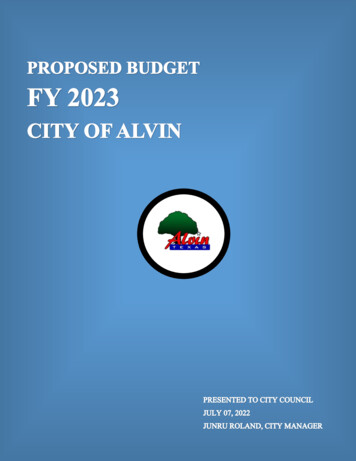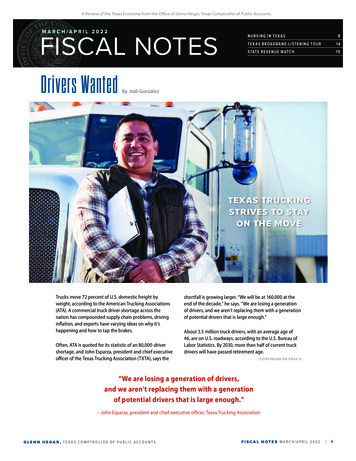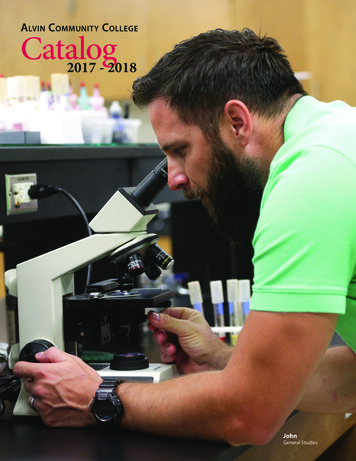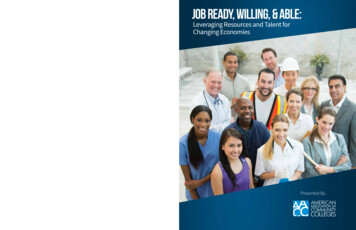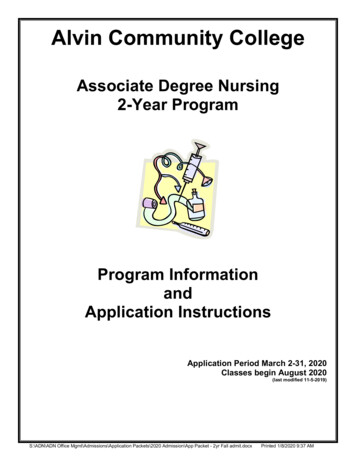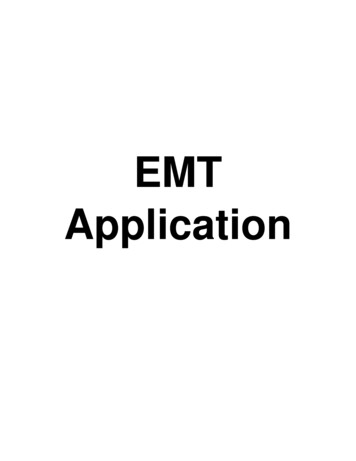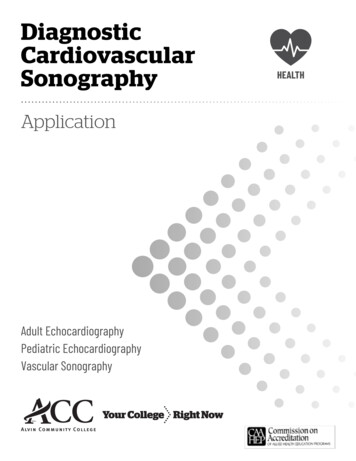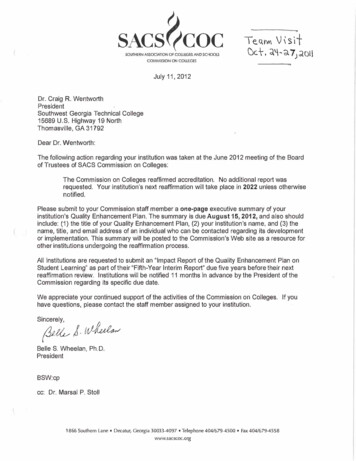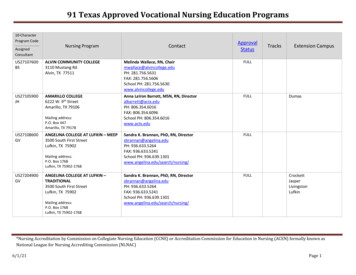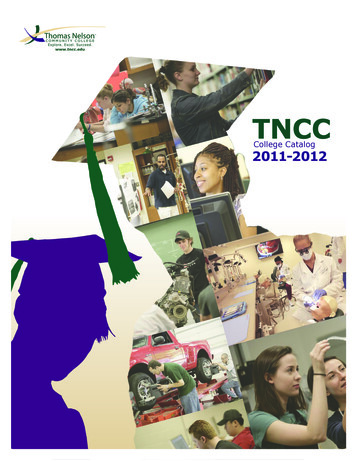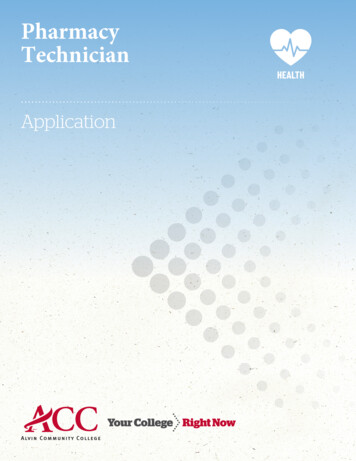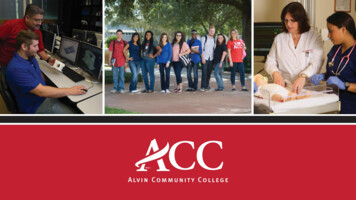
Transcription
About Alvin Community College Serving the community for nearly 70 years More than 30 Associate Degree programs More than 20 certificate programs Five programs offered entirely online More than 150 online courses Evening and Saturday Classes 8, 12, and 3-week mini-courses
About ACC Students Average age of 23 56% - female 44% - male 77% - part-time 81% - academic programs
Who Are Our Students? Over 77% are first generation Defined as students whose parents have notcompleted a bachelor’s degree 25% are married and 36% have children 53% work more than 20 hours per week 19% are not native English speakers
Enrollment Trends Fall 2016 enrollment - 5,674 Fall 2015 enrollment – 5,111 11% increase in headcount 10% increase in contact hours10.9 %9.9 %
ACC Fall to Spring %65.7%62.0%60.0%Fall 2010Fall 2011Fall 2012Fall 2013Fall 2014Fall 2015
ACC Graduation al2014-20152015-2016
Top 5 Programs for graduates General Studies Process Technology Nursing Business Administration Health Science
Notable Programs Police Academy Pediatric Echocardiography Process Technology Cardiovascular sonography Polysomnography Nursing Pharmacy Technician Associate Degrees for Transferring
Tuition and Fees Per Credit Hour In District - 45* Out of district - 90 Out of state - 140 Fees - 137 a semesterACC serves communities of Alvin, Manvel, Danbury, Pearland, Santa Fe, Angletonand surrounding area.*based on Fall 2016 rates
Tuition and Fees Comparison(Full-Time – Two Semester Enrollment)At Alvin Community College (In-District)*Tuition/Fees/Books/Supplies/Living at home 3,609Texas Public University (Texas resident)*Tuition/Fees/Books/Supplies/Room and board 18,123
Admission Questions To Consider WhenChoosing A College Placement TestingBacterial Meningitis VaccineTranscriptsStudent OrientationAverage Class Size – Student Professor RatioPayment Plans, Financial Aid, In-District FeesDeclaring a Major – Degree Plans
Certificates, Associates, and Bachelor Degrees Certificates can be awarded through continuing education or credit. Continuing education courses do not traditionally transfer. Credit certificates can be awarded independently or can build up towardthe associate degree. Associate of Arts and Associate of Science are designed for studentstransferring to a 4-year college or university. Associate of Applied Science is designed for students to learn skills to beemployed after graduation. Bachelor of Arts or Science is a four-year degree
Graduation Rates of ACC Transfer StudentsFall 2011 (Texas Higher Education Coordinating Board) Sam Houston State University Stephen F. Austin Texas State University University of Houston – Clear Lake University of Houston – Downtown University of Houston University of Texas – Arlington University of Texas Medical Branch – Galveston Other Public 4-Year Institutions Institution Total63%88%75%67%50%58%71%100%61%67%
Top 10 Four Year Institutions Where ACCStudents Transfer
Continuing Education/Workforce Development Welding CNC Certified Medical Assistant Dental Assistant Massage Therapy Truck Driving
To Learn More About A College, Go To:https://collegescorecard.ed.gov/Information regardingPaying for collegeCompare college dataEnrollment informationOffered by the Department of Education
Financial Aid 101 –Dora SimsACC Financial Aid Director
Tip #1 – Apply for Financial Aid FAFSA – Free Application for FederalStudent Aid Apply online at https://fafsa.ed.gov Obtain your FSA ID Everyone qualifiesfor some form of financial aid Use the IRS Data Retrieval Tool (DRT) tocomplete the tax sections for parent andstudent Scholarships College or university websiteEmployers, banks, other affiliationsInternet sitesVeteran benefits for dependents
Tip #2 - Special CircumstancesNotify your financial aid advisor if youhave one or both of the following Changes in income Loss of employment
Tip #3 - Email and WebAdvisors Check email and respond to allrequests Mark each schools’ domain as“safe” (ex: @alvincollege.edu) Always include your full name, IDNumber (not SSN) and semesterfor which you are inquiring Check your school’s WebAdvisorfor information and updates
Tip #4 – Ask Before Dropping Classes Satisfactory Academic Progress (SAP) –must maintain completion rate and GPA Certain types of aid require minimumenrollment Limit on number of times students candrop/withdrawal (state and federal) Withdrawing from classes and/or lowGPA can result in paying back financialaid or being placed on probation
Tip #5 – School or Scam? FOLLOW INSTRUCTIONS Read, follow directions, ask questions, andrespond NEVER pay to receive aid FAFSA.ed.gov - not .com or .net Legitimate scholarships do not charge a feeto complete an application
Financial Aid Trends Federal loan interest rates are still lowand have been capped Pell Grant Lifetime Eligibility Limit –equivalent of 12 full-time semesters Federal loan limits and loss of subsidyfor not completing your degree
Changes to the FAFSA for 2017-18 Students will be able to submit a 2017-18 FAFSA as early as October 1, 2016,rather than beginning on January 1, 2017. Students and parents will report income information from an earlier tax year (2015instead of 2016). The 2016-2017 financial aid application year runs from July 1, 2016 to June 30, 2017. The 2017-2018 financial aid application year runs from July 1, 2017 to June 30, 2018. IF YOU PLAN TO ATTEND COLLEGE DURING THE FOLLOW SEMESTERS: Fall 2016, Spring 2017 and Summer 2017 APPLY NOW!Fall 2017, Spring 2018, and Summer 2018 Apply as early as October 1, 2016 – June 30, 2018
Helpful Websites https://studentaid.ed.gov/sa/ https://fafsa.ed.gov/ https://www.youtube.com/user/FederalStudentAid - You Tube videos onfinancial aid assistance https://studentaid.ed.gov/sa/resources
For More Financial Aid Information:fa@alvincollege.edu(281) 756-3524
Questions? Social media Website www.alvincollege.edu Call 281.756.3500 Marilyn Dement – 281-756-3517
Changes to the FAFSA for 2017-18 Students will be able to submit a 2017-18 FAFSA as early as October 1, 2016, rather than beginning on January 1, 2017. Students and parents will report income information from an earlier tax year (2015 instead of 2016). The 2016-2017 financial aid application year runs from July 1, 2016 to June 30, 2017. The 2017-2018 financial aid application .
